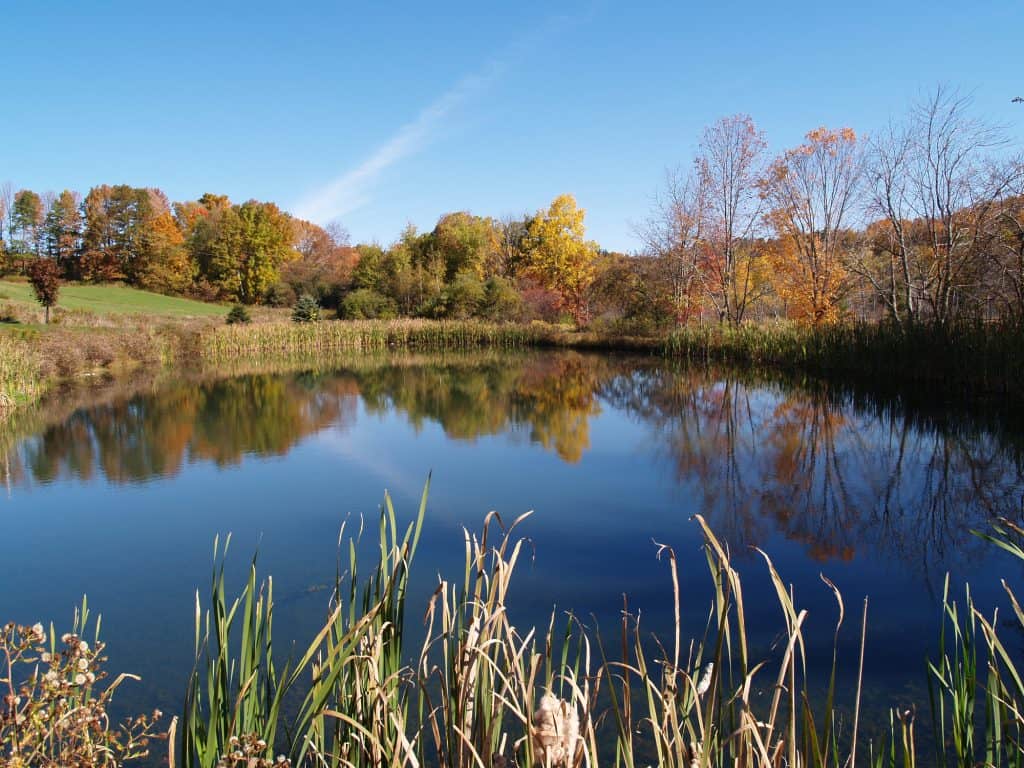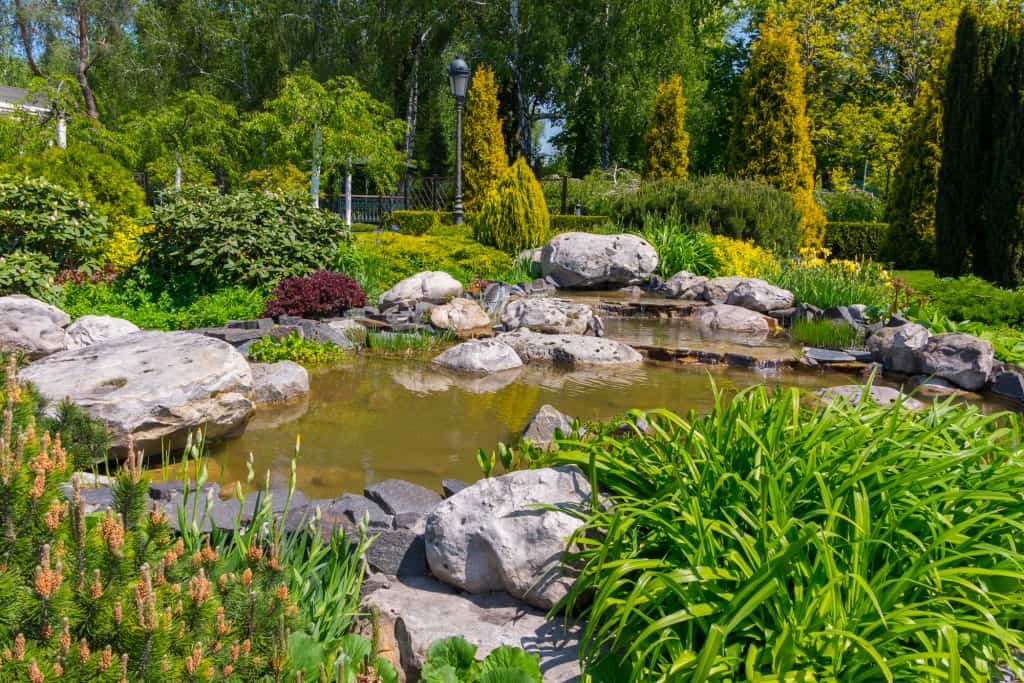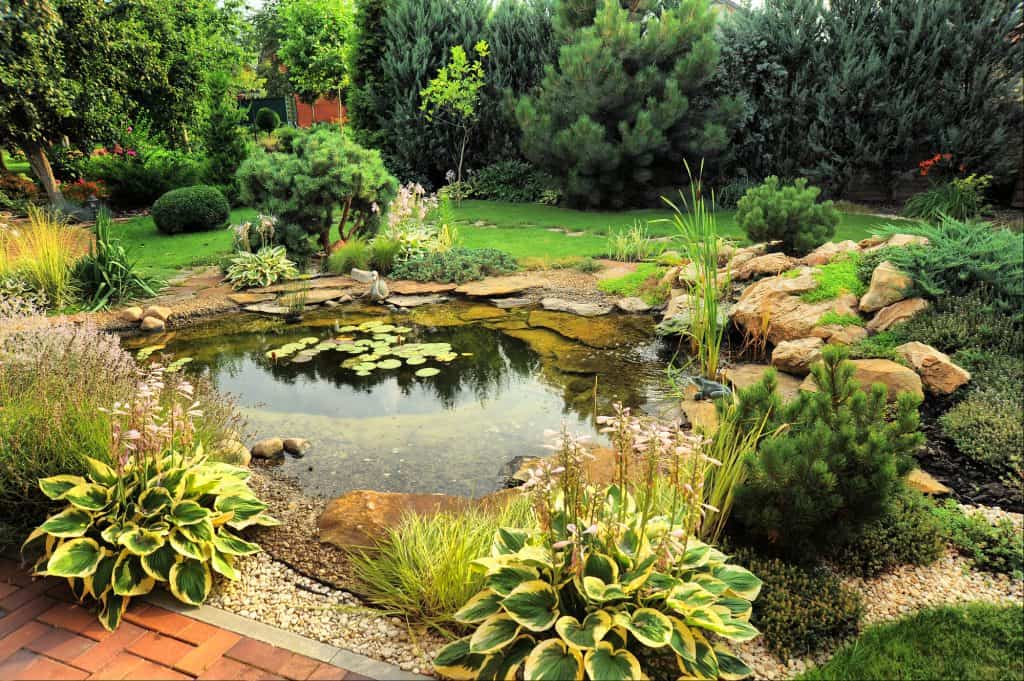Many years ago, we owned a small farm that had an excessive amount of ponds on the property. The person who owned the land before us really liked fishing and wanted to have as many opportunities to do that as possible.
Unfortunately for us, we didn’t know that it took quite a bit of time, effort, and money to keep these ponds in good shape. Even (and especially) the fishless pond on the property required upkeep that we weren’t prepared to provide.
Things that stuck out were how the pond algae took over in the spring, how it didn’t seem like I could ever get the pond plants under control, and how bad one of the ponds smelled depending on the time of year.
Since you’re here, I’m assuming you have a smelly pond water problem as well. Don’t fear — I’m here to help share my learnings to help you diagnose and fix your bad pond odors.
Generally, unpleasant odors are a result of stagnant ponds, which typically occur from an accumulation of pond waste, an abundance of algae, and a lack of filtration and water movement. This stagnant water can kill pond plants, attract pests like mosquitoes, cause a rotten egg smell, and even result in dead fish.
Why Stagnant Water Smells
What exactly causes the kind of rotten egg smell that occurs when water is stagnant?
Simply put, decaying plant and animal matter produce hydrogen sulfide as a byproduct. As the bacteria use the dead flora and fauna as a source of food, this waste accumulates in the water. The stagnation means that the foul-smelling waste has nowhere to go and will fester.
Additionally, the lack of flowing water can contribute to unsightly algae blooms, adding to the organic waste available to the bacteria.

Step-by-step Guide to Fix and Prevent Smelly Pond Water
To have a healthy fish pond, you must first diagnose why the ecosystem is out of whack. For example, if you only have a modest amount of sludge buildup in your pond, it’s probably not worth your time to address. You would get more mileage out of another approach.
I’m going to go through each of the steps I’d take to get rid of a bad odor in my own pond. However, there’s a good chance your own pond won’t need all of these steps. Because of that, I’m going to try to help you diagnose whether each issue is a problem.
Install an adequate aeration system
Of all the things you can do, installing an aeration system (preferably a fountain) is most likely to provide the best results for improving your pond health. Unfortunately, it’s also the most expensive option, with a full system costing between $1,500 and $6,000 if professionally installed.
While this is a lot of money, the aeration system will last for many years and can average out to a relatively low lifetime cost.
The aeration system itself will mix your pond water with the oxygen from above the surface. This oxygenated air does a few things for your pond.
First, it provides the good aerobic bacteria with a needed fuel source. Without the good bacteria, the “bad” anaerobic bacteria that produce a smell like rotten eggs will proliferate and dominate the pond ecosystem. When oxygen is present, the aerobic bacteria will help break down organic material into simpler, harmless forms.

Next, let me correct myself on something — anaerobic bacteria is not actually bad. Both aerobic bacteria and anaerobic bacteria are necessary for a healthy pond. They have a symbiosis with each other that works to completely eliminate fish waste, dead plant life, and other organic matter.
So, why then do we focus on aerobic bacteria? Simply put, anaerobic bacteria don’t have an issue surviving in a pond environment. They exist down at the bottom, where the pond muck and dead aquatic organisms fall.
These bacteria thrive here and there will be no shortage of pond sludge for them to consume. Fresh oxygen, however, is much needed in a natural pond.
Finally, aeration helps provide pond fish with a healthy, homeostatic environment to thrive.
Treat the pond with beneficial bacteria
If an aeration system simply isn’t in the cards, the next best thing is to supplement your pond with the kind of beneficial bacteria that it needs. Yes — you can actually purchase aerobic bacteria from outdoor supply stores and even Amazon (here’s one we found).
To apply this to your pond water, you need to follow the manufacturer’s directions for the product you purchase.
And one other word of note: if you have a fish pond, make sure the product you buy indicates that it is free from harmful chemicals. The last thing you want to do is to make your pond smell nice in the short term, but end up with dead pond fish.
Eliminate sludge buildup (if applicable)
This step is only applicable if your bad pond smells are actually coming from sludge buildup. If you don’t have any buildup to speak of, there’s no reason to try this step.
Now, it’s beyond the scope of this post to teach you how to remove the sludge build-up. However, here’s a video where someone completely removes the sludge from their pond with a pond vaccuum. They do this maintenance once per year and removing the pond muck helps keep their water feature clear and safe for fish.
Once you’ve removed the sludge, it’s time to think about how to prevent sludge buildup. Luckily, a lot of the steps we’re going to perform to fix the smelly pond water will also assist when addressing sludge buildup. Aeration, helpful bacteria, and a filtration system also help take care of sludge.
Additionally, you want to consider approaches that reduce the total amount of dead organic waste produced in your pond’s ecosystem. As this guide points out, adding a leaf net or pond vacuum can also do wonders.
Fix your algae blooms (if applicable)

Algae blooms are also not necessarily present in all smelly pond situations. However, when they are, they are a massive contributor to the organic waste causing the issue.
Now, most ponds will have some amount of algae living in the water. This is actually a good thing; algae are an expected feature of most bodies of water. In fact, an appropriate amount of algae actually helps eliminate your unwanted pond smells.
You see, algae perform an integral role in any pond ecosystem by consuming nitrates — these are the final by-product of the nitrogen cycle in a pond. The nitrates are left behind when the beneficial bacteria present finish doing their work.
Too high of a concentration of nitrates will destroy your pond and can result in sickness for your pond fish. In severe cases, even mass death.
All of this to say you likely don’t want to go all the way with algae removal in all but a small garden pond. Additionally, you should consider replacing the algae with pond plants like cattails or lilypads. Plants absorb nutrients and contribute to a healthy fish pond.
With this being said, large algae blooms need to be dealt with and there are straightforward approaches for algae removal. For example, here’s a pond treatment you can apply to help dissolve your large algae blooms.

Have realistic expectations
Finally, I’d like to include a word on setting proper expectations. While there are things you can do to keep your pond smell to a minimum, the fact is that pond water will never be odorless.
Crystal clear water shouldn’t be a goal — you’re going to have floating algae, natural bacteria, insects, and plant life all around the water feature. Of course, you don’t have to resign yourself to smelly, stagnant pond water. But nature is going to do what nature is going to do.
If you’re looking for a pristine water feature with no organic debris, you likely want a pool instead.

